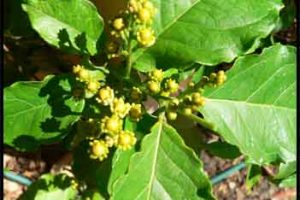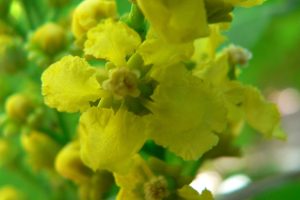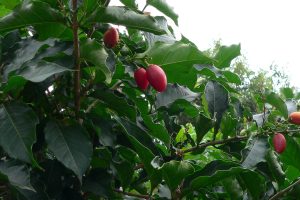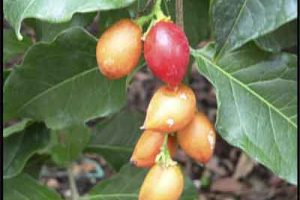Bunchosia armeniaca
Peanut butter fruit, ciruela
Origin
Native to Columbia, Equador, Peru and Bolivia. Taxonomy of the genus is difficult and the species armeniaca and argentea are often confused in public information sources. It is not widely known elsewhere and is grown in South America only as a backyard tree.
Climate
It is a hardy tropical species that grows up to 2400m in Andean regions. When mature it can tolerate brief light frosts.
Plant Description
A perennial evergreen shrub or small tree up to 5m high, often with multiple trunks. Leaves are simple, opposite, ovate, up to 15cm long and 8cm wide with a wavy margin; they form a very ornamental canopy. B. armeniaca is hexaploid.
Relatives
Malpighiaceae Family. There are a number of Bunchosia species. In the wider family, acerola or Barbados cherry, and nance (Byrsonima crassifolia) are relatives.
Soils
Moist and fertile loamy soils, rich in organic matter and having a pH of 6-7.6 are preferred.
Propagation
Seeds, with no established cultivars.
Cultivars
None known
Flowering and Pollination
The regular small lemon-yellow flowers appearing mainly in Spring are androgynous, lightly perfumed and arranged in axillary racemose inflorescences up to 8cm long. There are typically 10 stamens but half may be reduced to staminodes. The gynoecium has a single pistil with usually 3 carpels and a superior ovary. Insects may not be attracted to the flowers: best to try hand pollination.
Cultivation
Rainfall and irrigation should be managed to ensure moist soil conditions, and although it prefers full sun it will tolerate partial shade. With the light infertile sandy soils common in south west WA, there may be periodic nutrient problems that need to be addressed.
Wind Tolerance
Not reported, but not really a problem when it is trained as a small bush.
Pruning
After training when young, pruning is restricted to removal of dead and crossing branches.
The Fruit
These are indehiscent, 2cm long ovoid berries with pale green skin turning to orange then red as they mature. There are 1-2 large seeds embedded in the orange-red pulp. The texture and flavour of firm, orange-coloured, slightly unripe fruit resemble carrots. Once the fruit becomes red and soft, the flavour is sweet and surprisingly for a moist fruit, the texture resembles peanut butter.
Fruit Production and Harvesting
Harvesting is staggered, and depending on environmental conditions and management there may be more than one crop per year, as for acerola. It is best to pick the fruit while they are still orange and firm; they will soften and redden within a day or two. Birds are particularly fond of the soft, red fruits when left on the tree.
Fruit Uses
It is usually eaten fresh but can also be used in milk shakes, jams, muffins and the like. Fruits can be dried, and resemble dry figs.
Pests and Diseases
Appears relatively trouble-free once established.
Comments
This plant grows well in the Perth area and while producing an unusual fruit, it could be grown solely for its ornamental or screening value. It is self-fertile so you only need one plant for fruiting.



